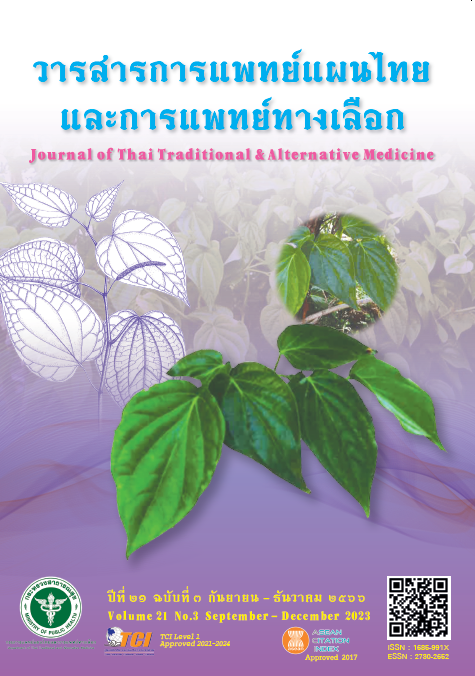Comparative Effectiveness of Cannabis versus Plai Ointments for Neck and Shoulder Pain Relief in Staffs of Renu Nakhon Hospital, Nakhon Phanom Province
Main Article Content
Abstract
Introduction and objective: Neck and shoulder pain is the common cause of chronic pain, affecting health status, quality of life, mood status and treatment costs. Currently, the herb “cannabis” is used in the form of oil and spray to treat pain in cancer patients. Nevertheless, clinical evidence to support the effectiveness of cannabis ointments for neck and shoulder pain relief is still lacking. This study aimed to explore the effectiveness of cannabis versus plai ointments for neck and shoulder pain relief.
Methods: Participants were staff members of Renu Nakhon Hospital, Nakhon Phanom province that were outpatients at the Renu Nakhon Thai Traditional and Alternative Medicine Clinic from November 2021 to March 2022. They were diagnosed with neck and shoulder pain by a Thai traditional medical doctor. Sixty participants who met the inclusion and exclusion criteria were equally randomized into two groups by simple random sampling without replacement method. They applied the ointments at the neck and shoulders twice daily for 14 days. The levels of pain were determined by patients using numeric rating scale (NRS; score 0-10). Data records, general information and information/symptoms about the history of neck and shoulder pain, were analyzed using frequency, percentage, mean and standard deviation. Mean NRS scores of the differences from baseline were compared within and between the two groups and analyzed using paired t-test and unpaired t-test, respectively.
Results: Both cannabis and plai ointments could significantly reduce neck and shoulder pain. NRS scores were significantly lower than the baseline (P<0.001) on day 7 in the cannabis group and day 3 in the phai group. However, there were no significant differences between the two groups. No side effects were found in this study.
Discussion: In this quasi-experimental study, due to several limitations, especially the herbal odors, both sides of the experiment could not be concealed. The pain measurement scales also had limitations and patients’ individual topical applications might be different; and they could affect the drugs’ efficacies.
Conclusion and recommendation: Cannabis ointments can relieve neck and shoulder pain; so it may be a herbal choice for external use for such condition.
Article Details

This work is licensed under a Creative Commons Attribution-NonCommercial-NoDerivatives 4.0 International License.
References
Raksanon T, Charee C, Wareekajonkiet P, Chalardlerd P. Guidelines for providing occupational health services to workers in the community in ergonomics for primary health service staff. Nonthaburi: Ministry of Public Health; 2022. (in Thai)
Bernard B, Putz-Anderson V. Musculoskeletal disorders and workplace factors: A critical review of epidemiologic evidence for work-related musculoskeletal disorders of the neck, upper extremity, and low back [Internet]. U.S. Department of Health and Human Services, Public Health Service, Centers for Disease Control and Prevention, National Institute for Occupational Safety and Health; 1997.
Kittiboonyakun P, Ploylearmsang C, Somsaard P, Suttajit S, Leelathanalerk A, Srimongkhol P. The study reviewed the efficacy and economic cost-effectiveness of pain and inflammation treatment of selective cyclooxygenase inhibitors (COX-II inhibitors). Bangkok: Health Insurance System Research Office; 2012. (in Thai)
Lanas A, Garcia-Tell G, Armada B, Oteo-Alvaro A. Prescription patterns and appropriateness of NSAID therapy according to gastrointestinal risk and cardiovascular history in patients with diagnoses of osteoarthritis. BMC Medicine [Internet]. 2011 [cited 14 April 2021]; 38:1-7. Available from: https://bmcmedicine.biomedcentral.com/articles/10.1186/1741-7015-9-38.
Chongmelaxme B, Sruamsiri R, Dilokthornsakul P, Dhippayom T, Kongkaew C, Saokaew S, Chuthaputti A, Chaiyakunapruk N. Clinical effects of Zingiber cassumunar (Plai): A systematic review. Complementary therapies in medicine. 2017;35:70-7.
Department of Thai Traditional and Alternative Medicine. Caring for patients with chronic musculoskeletal pain syndrome with integrative medicine. Bangkok: The War Veterans Organization of Thailand Under Royal Patronage His majesty the King printery; (2022). (in Thai)
Loupattarakasem W, Kowsuwon W, Laupattarakasem P, Eungpinitpong W. Efficacy of Zingiber cassumunar ROXB. (Plygesal) in the treatment of ankle sprain. SRIMEDJ [Internet]. 2013;8(3):159-64. (in Thai)
Ministry of Public Health. National Master Plan on Thai Herb Development No. 1 2017-2021. Nonthaburi: Department of Thai Traditional and Alternative Medicine; 2559. (in Thai)
FDA Thai press release. Unlock Marijuana & Hemp #Use marijuana wisely [Pamphlet]. Nonthaburi: Food and Drug Administration; 2022. (in Thai)
Furrer D, Kröger E, Marcotte M, Jauvin N, Bélanger R, Ware M, Foldes-Busque G, Aubin M, Pluye P, Dionne CE. Cannabis against chronic musculoskeletal pain: a scoping review on users and their perceptions. J Cannabis Res. 2021;3:1-28.
Nielsen S, Picco L, Murnion B, Winters B, Matheson J, Graham M, Campbell G, Parvaresh L, Khor K-E, Betz-Stablein B, Farrell M, Lintzeris N, Le Foll B. Opioid-sparing effect of cannabinoids for analgesia: an updated systematic review and meta-analysis of preclinical and clinical studies. Neuropsychopharmacology [Internet]. 2022;47(7):1315-30.
Maghfour J, Rundle CW, Rietcheck HR, Dercon S, Lio P, Mamo A, Runion TM, Fernandez J, Kahn J, Dellavalle RP, Yardley H. Assessing the effects of topical cannabidiol in patients with atopic dermatitis. Dermatology online journal. 2021;27(2):1-4.
Sivesind TE, Maghfour J, Rietcheck H, Kamel K, Malik AS, Dellavalle RP. Cannabinoids for the treatment of dermatologic conditions. JID Innov. 2022;2(2):100095.
Bunpean A, Nicharojana LO. Effects of massage with Plai juice and Plai oil on the relief of neck and shoulders pain: A study from Kanchanabhishek Institute of Medical and Public Health Technology. The Southern College Network Journal of Nursing Public Health [Internet]. 2019;6(1):121-30. (in Thai)
Jirawatkul A. Biostatistics for health science research. 3rd ed. Department of Statistics and Demographics, Faculty of Public Health, Khon Kaen University. KhonKaen: Klungnana Vitthaya Press; 2008. (in Thai)
Nootim P. A comparative of efficacy between Sahasthara and Diclofenac tablet for muscle pain relief. [Thesis]. Nakhon Pathom: Silpakorn University; 2012. (in Thai)
Shin G, Feng Y, Jarrahi MH, Gafinowitz N. Beyond novelty effect: a mixed-methods exploration into the motivation for long-term activity tracker use. JAMIA Open. 2018;2(1):62-72.
McCarney R, Warner J, Iliffe S, Van Haselen R, Griffin M, Fisher P. The Hawthorne Effect: a randomized, controlled trial. BMC Med Res Methodol. 2007;7:30.
Adair JG. The Hawthorne Effect: a reconsideration of the methodological artifact. Int J Appl Psychol. 1984;69:334.


